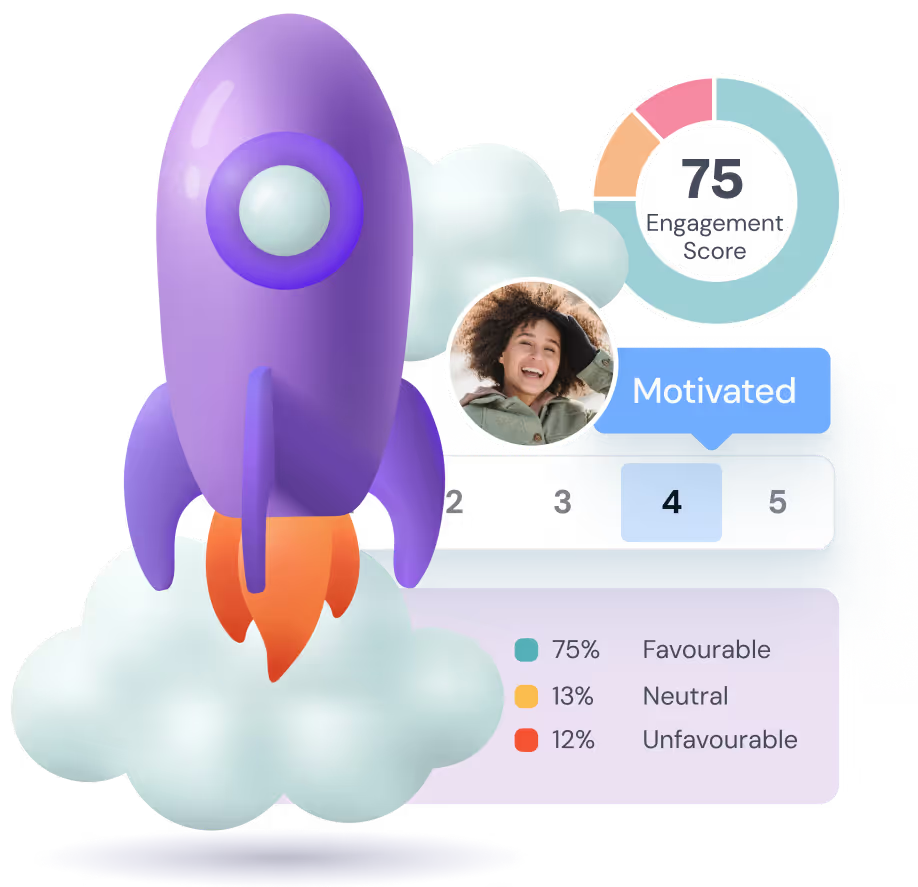Employees are the heart and soul of any organization. When they're engaged, their productivity and morale increases.
However, when they're disengaged, they won't feel like putting in extra effort at work. They display signs opposite to a brand advocate, and wouldn't recommend their workplace as a good place to work.
Poor engagement can negatively affect employee performance and cause your employees to be less productive at work.
So to avoid this, let's go over 10 strategies to improve your employees' engagement, and keep their productivity and satisfaction levels from dropping.
17 Employee Engagement Strategies for Building a Successful Workplace
In the words of Stephen R Covey,
"Always treat your employees exactly as you want them to treat your best customers."
Executing a strategy alone isn't enough, as employees can only be engaged if they want to.
That means you'll have to find different strategies to do it.
Here are some of them.
1. Measure Current Engagement Levels
It's simple. You can't improve what you don't measure.
So, begin by surveying your employees.
Conducting an engagement survey is a good way to measure current engagement levels, spur your employee engagement strategy, and tune your efforts in the right direction.
You can then use the results from your survey to find who's engaged and who isn't.

Try ThriveSparrow for free, and visualize your organization's engagement levels across departments, teams, and reporting factors. With an analytical approach such as this, you can ensure your engagement efforts work and lead to better outcomes. Become the HR everybody loves. Get started engaging your employees with a free trial today.
2. Encourage Transparent and Open Communication
Transparency builds trust — and trust fuels engagement.
Make sure your employees are kept in the loop about key updates, company decisions, and the reasoning behind them.
Withholding information can create uncertainty, while open communication fosters confidence and alignment.
Encourage two-way communication instead of one-way announcements. Give employees a voice in discussions that impact them, and make it easy for them to share feedback or raise concerns.
You can:
- Maintain an open-door policy where managers are approachable and ready to listen.
- Host anonymous AMA (Ask Me Anything) sessions where employees submit questions, and leaders respond openly.
- Use digital feedback channels or pulse surveys to keep the dialogue continuous.
When communication feels honest and inclusive, employees feel valued — and that sense of trust directly strengthens engagement across the organization.
3. Conduct Engagement Activities
Every employee is part of the organization. All of them function as a community, taking from one another and contributing to the larger picture.
Conducting some fun activities can bolster engagement and improve collaboration between many.

Team-building activities, games and competitions, quizzes, workplace parties, and virtual coffee sessions are wonderful activities that can be conducted at the workplace to boost engagement.
4. Recognize and Appreciate Your Employees Where It Matters Most
When employees aren't engaged. They may not bring out their best performance. In addition to this, your top talent may be looking for other job opportunities.
That is why, creating a recognition rich-environment filled with rewards and incentives can help them feel valued.
According to Gallup,
'When recognition hits the mark, employees are five times as likely to be connected to company culture and four times as likely to be engaged.'
An employee recognition program can help you facilitate peer-to-peer recognition, and reward high-performance and other achievements. With a recognition system in place, other employees can also join in on celebrating achievements, helping foster a positive work atmosphere.
Including rewards in your recognition program can motivate your employees to achieve more milestones and perform better.

Small instances of appreciation can go a long way. In addition to celebrating milestones and achievements, you can encourage your employees to celebrate small wins, efforts, and hard work with each other using appreciation messages.
These small gestures even though small, can have a significant improvement in your employees' sentiment.

5. Invest In their Growth
Every person in an organization is important. Employees who are highly skilled and well-trained serve as a company's best assets. That is why, providing regular opportunities for your employees' development and growth is crucial for maintaining a high-performance culture.
Employees also love it when you invest in their professional growth. It adds value to both their personal and professional lives. As a result, they'll tend to be more engaged and happy and will contribute more than required to achieve a company's goals.
6. Encourage Your Managers to be More Like Leaders
1. Good leadership positively impacts workplace dynamics.
Employees communicate with their managers on a regular basis. And engagement stems on the daily interactions between the two.
You may have heard of this famous quote,
Employees don't leave jobs, they leave their bosses.
A 2019 study by DDI found that 57% of employees left their previous job due to their managers.
Therefore, educating a manager on how to be a better boss and what leadership qualities they should embody to engage their employees is something that should be prioritized. Additionally, managers can ask assess a team's engagement by asking them certain questions. This provides managers with a clear picture of the team's engagement.
Another way to keep tabs on a teams' engagement is to conduct regular one-on-one meetings.
While hiring new managers, perform a behavioural assessment. This helps you check if the candidate meets the required needs of your company and is a good culture fit.
Read more: The Leader's guide to fostering a positive organizational culture
2. Managers play a key role in their employees' engagement.
Over 70% of the variance in engagement correlates to the manager (Source: Gallup Business Journal, 2015). When managers are engaged and perform their roles effectively, their teams follow suit.
Kevin Kruse explains the importance of managers perfectly: it doesn’t matter what engagement strategy you implement—if your boss doesn’t change their behavior, those strategies won’t matter.
Ultimately, it all comes down to having the right kind of leader. With the right leadership, engagement will remain strong.
7. Give Your Employees a Sense of Purpose At Work
Employees aren’t just human capital — they’re much more. They help steer an organization toward its goals. When you show employees how valuable their work is and how it contributes to the organization’s success, it instills a sense of purpose and makes them feel like important contributors.
Everyone seeks purpose in their lives — including their work life. A low sense of purpose, or a lack thereof, can lead employees to leave their positions sooner, indicating disengagement at work.
82% of employees want to be viewed as a person, not just an employee, Gartner stated in a recent article.
So, respect every employee’s opinion and make it a priority to discuss their ideas and perspectives during conversations.
8. Offer Flexible Working Hours
Removing the constraints on work arrangements can help bring about a greater work-life balance for your employees.
Offering flexible work schedules helps organizations increase their ability to attract, retain, and motivate high-performing and experienced individuals.
Other benefits of offering a flexible work schedule include:
- Greater productivity
- Enhanced engagement
- Reduced absenteeism
- Improved health
- Reduced stress
- Increased creativity
- Low chances of burnout
- Job satisfaction

Apart from just offering a flexible work schedule, implementing other flexible arrangements, where tasks are divided between two employees, can also be beneficial. Such a process provides organizations with a safeguard against unforeseen layoffs.
9. Check In Regularly With Your Employees
Regular check-ins allow you to gauge your employees' pulse and uncover potential issues before they arise.
One-on-one meetings are a good way for managers to check-in regularly with their employees and ask them how they feel about various happenings in the company.
This is especially important for remote employees. According to Harvard Business, 40% of surveyed employees felt isolated both emotionally and physically from the workspace.
Therefore, ensuring regular check-ins is pivotal to your employees' engagement.
10. Analyze Employee Feedback and Reiterate Your Engagement Strategy
Regularly collecting feedback and using it to guide your engagement efforts lets you identify what strategies of yours are working and what isn't. This approach allows you to reiterate your strategy and make it better for improved outcomes.
There are many channels for collecting feedback, but you should also use one that allows you to interpret and analyze feedback.
Apart from one-on-one meetings, surveys are one of the best methods for collecting feedback, and an employee success platform like ThriveSparrow lets you analyze feedback easily through organized reports.
With it, you can view the engagement levels across departments and identify the reporting factors that are causing low engagement. This can help you target your engagement efforts towards those specific areas and get the best results.
11. Have a Robust Onboarding and Offboarding Program
A strong onboarding program can help you align new hires to the company's culture and make a good first impression on them. Incorporating a 'Buddy program' where the 'buddy' (current employee) shows the new hire around the company, is a good way to get the new person accustomed to the company's culture and practices.
It would also help the new hire break the ice and connect on an emotional level with everyone else more quickly. Pairing them with a mentor would also ensure a smooth transition.
It is good practice to conduct exit interviews when an employee decides to leave the company. An exit interview or survey can include questions about the employee's motives and reasons behind the switch.
The insights from the survey can also help you find out areas of improvement in your current employee engagement strategy, helping you reiterate and refine them later on.
12. Safe and Open Space to Share Thoughts
AMAs and town hall meetings lets employees voice their concerns and suggestions directly to the management team anonymously and in a non-judgemental setting.
This will help leaders share company news – both good and bad – openly with employees, fostering a culture of transparency and mutual trust.
13. Create a Diverse and Inclusive Atmosphere
Celebrate cultural diversity through events and awareness programs.
Ensure your recruitment processes are unbiased and inclusive of diverse talent.
Moreover, implement policies that actively promote inclusion, such as flexible work arrangements and support for different life stages and needs.
For example, organizations providing accessible parking spaces, elevators, rest-rooms, and cafeterias for handicapped employees helps them feel valuable and like they belong.
14. Prepare an Action Plan
After collecting feedback from employees, create a clear action plan with specific timelines and responsible persons. This shows employees that their input leads to real change. Regularly update the team on the progress of these action items, keeping the communication channels open and transparent.
15. Set SMART Goals
Encourage employees to set Specific, Measurable, Achievable, Relevant, and Time-bound (SMART) goals that align with their career aspirations and the company’s objectives. Also educate them on the benefits of setting goals the right way.
Have regular check-ins to review these goals, and provide them with the necessary support and resources to help employees set and achieve their goals.
An organized process with goals that are SMART is all an employee needs to keep him more engaged at work.
Also read: How to set goals at work?
16. Encourage Employee Development
Creating a clear career pathway for your employees encourages them to apply for senior roles or leadership positions.
Offer regular training and development workshops that not only focus on their job-related skills but also their personal development.
17. Incorporate Employee Assistance Programs (EAPs)
Incorporate EAPs that provide your employees with access to counseling and mental health services that can help them in managing work-related stress and personal issues.
You could also consider organizing well-being programs and activities such as health screenings, fitness challenges, and mindfulness sessions to promote a healthy work-life balance.
Wrapping up
Employee engagement initiatives are an essential component of a functioning organization. Organizations can improve employee satisfaction, retention, and performance by investing in these strategies and activities, resulting in increased success and growth.
















